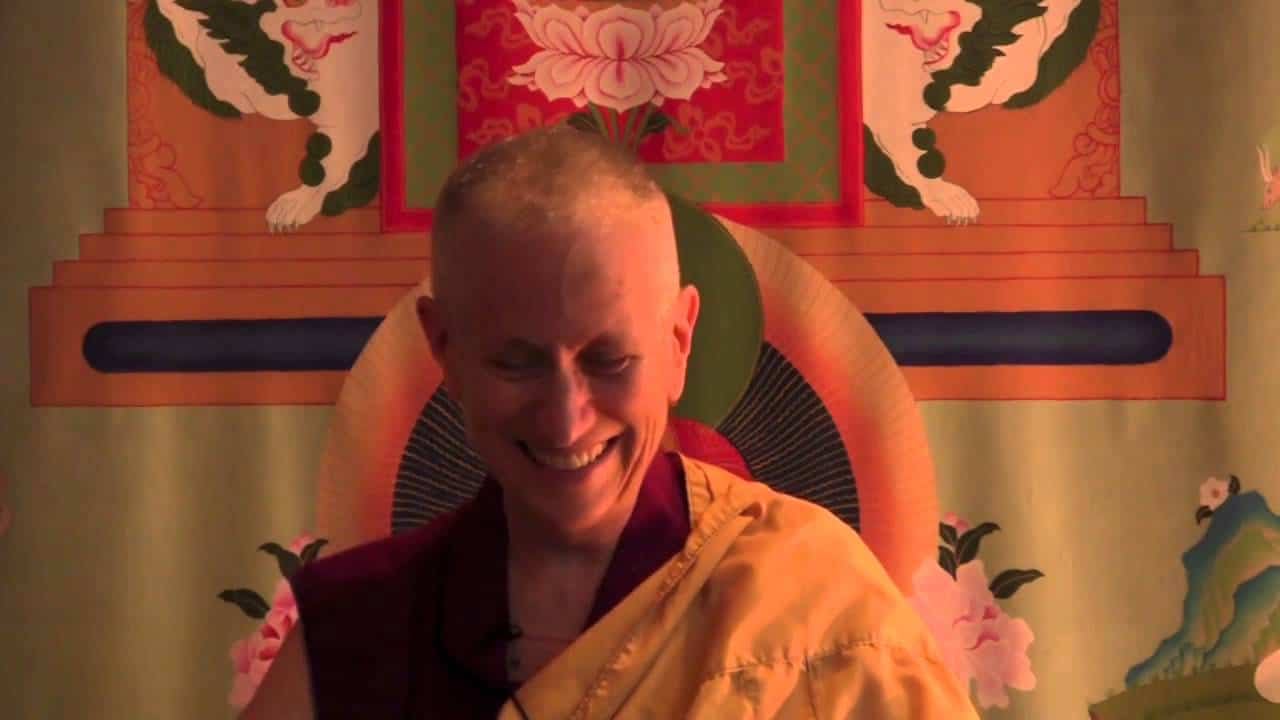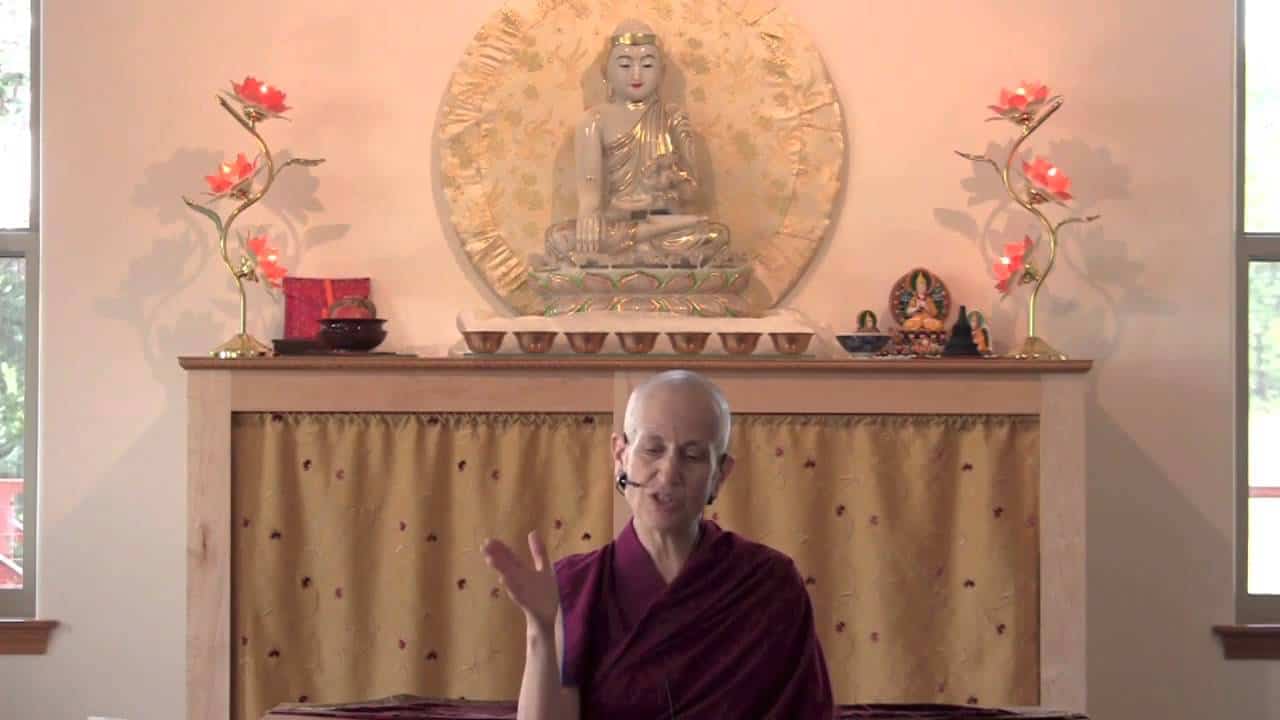Meditating on impermanence
Part of a series of teachings and short talks given during the Manjushri and Yamantaka Winter Retreat in 2015.
- Meditating on impermanence is not the same as meditating on emptiness
- Value of learning different reasonings when meditating on emptiness
- Importance of accumulating merit and doing purification practices
- Importance of being well-grounded in understanding cause and effect
This came in from the migration team (who’s migrating the thubtenchodron.org material). Heather wrote it and she said:
A number of us from the migration team are participating in the Manjushri retreat from afar. We have been posting your BBC videos on the volunteer blog along with discussion/contemplation questions in an effort to have our own sense of community while we’re doing retreat, supporting and encouraging each other.
Which is very nice. And then they had a question come up, so that’s what this is. So someone wrote (and I don’t really have the context for this question):
It helped me how Venerable touched on impermanence. No matter what approach to meditation on emptiness I try it always comes back to impermanence. The idea that my body changes from moment to moment, and that my mental states fluctuate constantly is something graspable for me. I was wondering, though, is it okay for me to use that imagery much of the time, or should I be trying harder to understand in other ways, such as the four-point analysis?
And then wishes all of us a very fruitful retreat.
Meditating on impermanence alone is not the same as meditating on emptiness. Meditating on impermanence sets the stage for meditating on emptiness because if things were truly existent then they would be permanent, because they would be self-enclosed identities—truly existent meaning it’s not affected by anything else, thus it couldn’t be affected by causes, thus it would be permanent. So that’s one of the reasons why things cannot be truly existent, because if they were they would be permanent. However, permanent is not the meaning of “truly existent.” It’s just the consequence of “if things were truly existent.” So therefore, meditating on the opposite of permanence—impermanence—is not the thing that’s directly going to counteract the grasping at inherent existence. It leads you into that. And the way it leads you into that …. His Holiness spoke on this not too long ago. But I really picked up on this because I kind of had this same question this person had many years ago. So His Holiness was saying the way meditating on impermanence leads into understanding emptiness is that things are impermanent because they’re produced by causes. Being produced by causes and conditions is the reason why things are impermanent. And causal dependence (which means dependent on causes and conditions—that affects depend on causes and conditions) is one of the types of dependent arisings that is the reason that proves emptiness of true existence. So to understand impermanence you have to understand that things depend on causes and conditions (that results depend on causes and conditions), and by understanding that kind of dependence then when you’re referring to products (or impermanent phenomena) thinking that they are dependent on their causes and conditions means that they cannot be independent, therefore they cannot exist inherently, because they’re dependent on their causes and conditions.
This kind of dependence can prove the emptiness of functioning things, but it doesn’t apply to all phenomena because things that are permanent are not dependent on causes and conditions. But it’s a very important reasoning that really leads you into an understanding of emptiness.
You’ll see on Thursday nights that a lot of our refutations are refutations involving looking at how things arise. Do they arise from self, other, both, or causelessly? Do they arise in the past, the present, or the future? A lot of the arguments we’re using are concerning functioning things, impermanent things. So it’s quite important to examine that whole thing.
In general, I think it’s good when we’re learning meditation on emptiness to learn various different reasonings. They say that the bodhisattvas always learn many, many reasonings so that they can look at emptiness from many different perspectives and investigate how things really exist from many different angles. While people on the hearer and solitary realizer vehicles usually just use one reasoning and stick with that. It leads to the same realization of emptiness—they both realize the same emptiness—but a bodhisattva’s realization of emptiness is so much more flexible because they’ve been able to look at the nature of reality from many, many different angles and perspectives.
So I think it is helpful to learn the different reasonings because they all point out different things to us.
Having said that, we also need to focus on the method aspect of the path. Sometimes people at the beginning hear about emptiness and “I just want to study emptiness and realize emptiness,” but as you begin studying you come to see it’s rather a difficult topic to understand. And then you read many many books, and this book says this, and that book says that, and they all have different vocabulary words in English, and then you read things by Western academics who have their own way of thinking that doesn’t necessarily agree with what the ancient masters have said, and then you’re [all confused].
In order to realize emptiness we have to have a lot of merit, and so it’s very important to create merit and do purification by engaging in the method aspects of the path. Those are the aspects of the path that have to do with generating the determination to be free from cyclic existence, generating love and compassion and bodhicitta, practicing generosity, ethical conduct, fortitude. All these kinds of practices really nourish the mind and make the mind more fertile for understanding emptiness. So that’s quite important to do.
Also, before you go into emptiness really deeply it’s important to be very well grounded in understanding cause and effect. Specifically in understanding karma and its effects, because people who aren’t well grounded in the conventional cause and effect—conventional reality of karma and its effects—it’s very easy for them when they hear emptiness to misunderstand emptiness and think that emptiness means that there’s no good, and there’s no bad, and nothing exists, so you can do whatever you want. And due to that wrong conception they then create tremendous negative karma which becomes the cause to be reborn in the lower realms. So we don’t want that. So for these reasons of having a firm foundation in cause and effect and also to be able to accumulate the merit that builds up the mind’s openness and receptivity, it’s also important to do all these other practices and to include in our study all the other topics in the lamrim that come before the topic of emptiness. And impermanence is included in that because you can see it comes in the meditations on the initial capacity of being when we meditate on impermanence and death to help us set our priorities. It comes in the practice of the person of middle capacity because they study the four truths of the aryas, and impermanence is one of the sixteen characteristics (one of the characteristics of true dukkha). So it’s a very important meditation also helping us to understand conventional reality correctly.
Venerable Thubten Chodron
Venerable Chodron emphasizes the practical application of Buddha’s teachings in our daily lives and is especially skilled at explaining them in ways easily understood and practiced by Westerners. She is well known for her warm, humorous, and lucid teachings. She was ordained as a Buddhist nun in 1977 by Kyabje Ling Rinpoche in Dharamsala, India, and in 1986 she received bhikshuni (full) ordination in Taiwan. Read her full bio.


